Sustainability: Batteries & Solar | Water | Heating
Batteries | Consumption | Battery Recharging | Solar Charging | How Long Without Sun? | Alternate Charging Options | Solar Regulators | The Bottom Line
-
- See also: 12V Wire & Cabling
- Case Studies: 12V power cut-outs | Battery not charging
- On the Go: DIY – Portable fridge & 12V power supply >>>
| Your 12V Electricity Supply – a quick summary…. | ||
|
||
| For tent and car campers (or a basic van setup)…. | ||
|
-
- See also: Lithium upgrade | Install a battery monitor | Install an inverter
Now for all the details…..
A renewable energy supply
![]() There is no doubt that recent advances in electrical technologies have transformed the modern campsite. Back in the day LPG was the universal energy source for refrigeration, lighting and cooking. Now 12V electrical energy can do all of that. And it is easily ‘renewable’…
There is no doubt that recent advances in electrical technologies have transformed the modern campsite. Back in the day LPG was the universal energy source for refrigeration, lighting and cooking. Now 12V electrical energy can do all of that. And it is easily ‘renewable’…
-
- LPG is stored in bottles that need to be refilled (or swapped) at retail outlets.
- 12V electricity is stored in batteries that can be recharged, on site, using solar energy.
Storage capacity
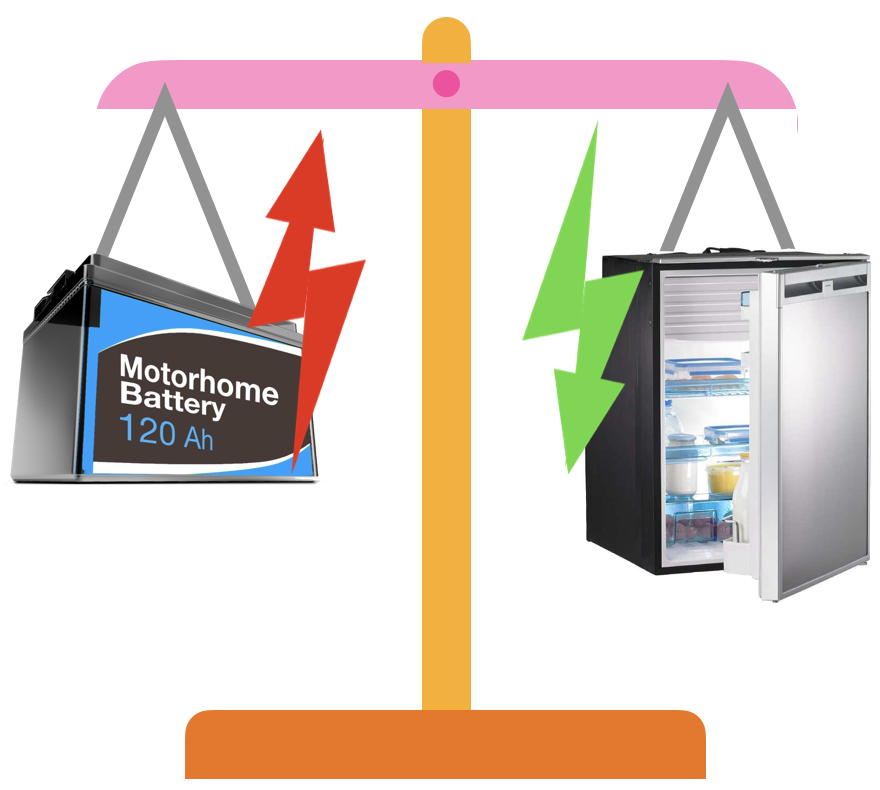 The first question that pops up for those pondering their 12V energy supply is: “What size battery do I need?”
The first question that pops up for those pondering their 12V energy supply is: “What size battery do I need?”
And that question can only be answered by first considering the 12V appliances you will be using, how much electricity they drain from the battery, and for how long you will be using them.
It is very much a balancing act between Capacity, Consumption and Recharging.
As a rough guide…..
-
- For weekends away in a tent (with vehicle support), a 100Ah AGM battery in a powered Battery Box (or possibly a 50Ah Lithium power station) is a minimum to keep your fridge cold for a couple of nights. Add a 150W solar panel (and solar controller/regulator) to extend the battery life in sunny conditions;
- For weekends away in a small Campervan with a built-in upright fridge, a single 120Ah Lithium battery will keep your fridge cold, lights on, and devices charged. Add a 150W solar panel to extend battery life.
- For longer periods of time away in a Campervan or Motorhome, 2 x 120Ah Lithium batteries (connected in parallel) providing 240Ah storage capacity, will not only keep your fridge cold, lights on, and devices charged, but will also provide enough energy for pumping water to the shower and running an inverter to power 230V appliances like a sandwich press or coffee machine. Add in 300W of solar panel capacity to keep your fridge cold for weeks;
- If you are driving most days, or staying in powered campsites, you will be able to manage all of the above with minimum battery capacity (120Ah) and less (or no) solar recharging capacity – if you have a DC-DC charger supplying current from the vehicle alternator to your camping battery;
- If you are free-camping for long periods of time (weeks) with little or no starting of your engine, and no access to mains power, you will need at least 240 Ah of battery capacity, with 300W+ of solar panel capacity to keep the batteries charged.
Monitoring our 12 Volt electricity supply
 To successfully manage our electricity supply we need to know how much electrical energy is stored in our batteries, and be able to measure the amount of electricity being consumed from the batteries by our appliances.
To successfully manage our electricity supply we need to know how much electrical energy is stored in our batteries, and be able to measure the amount of electricity being consumed from the batteries by our appliances.
Our electricity supply is measured in Volts and Amps.
A neat analogy to help understand these terms is a comparison with water flowing through pipes….
-
- Voltage (measured in Volts) is equivalent to the pressure pushing water through the pipes;
- Current (measured in Amperes, or Amps) is equivalent to the flow rate or the volume of water flowing through the pipes;
- A third factor, Resistance (measured in Ohms), is a measure of the difficulty the water has in flowing through of the pipes – eg, pipes that are too narrow in diameter might restrict the volume of water able to easily flow through the pipes;
- Battery storage capacity (measured in Amp/Hours) is equivalent to the amount of water stored in the water tank that is supplying water to the kitchen, shower, and garden sprinklers, via the pipes.
- Watts is a measure of electrical power (Watts = Volts x Amps). In the water analogy, this would be a measure of the power of the water turning a water wheel – a combination of the water pressure (Volts) and volume of water flow (Amps).
How do you make these electrical measurements? The image above is typical of a fixed monitor display in a Campervan or Motorhome (see installation link below). Portable in-line power meters are useful for checking Amps, Voltage and Watts being generated / consumed by portable equipment, connecting to your system with Anderson plugs….
-
- Example: ATEM Power Meter >>>
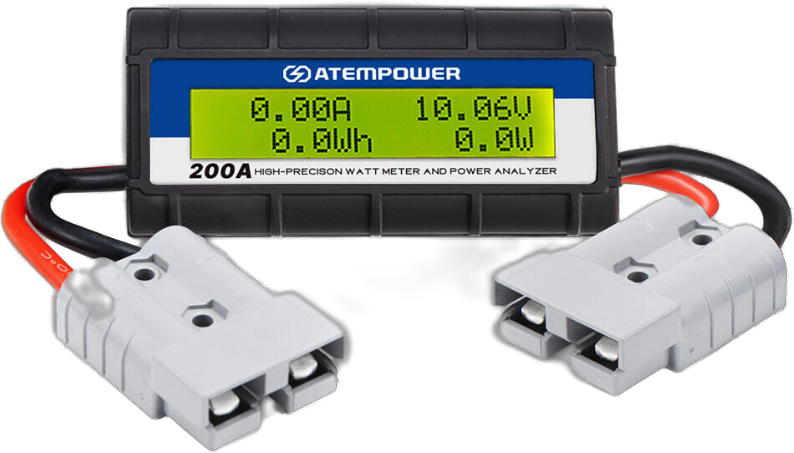
Appliances
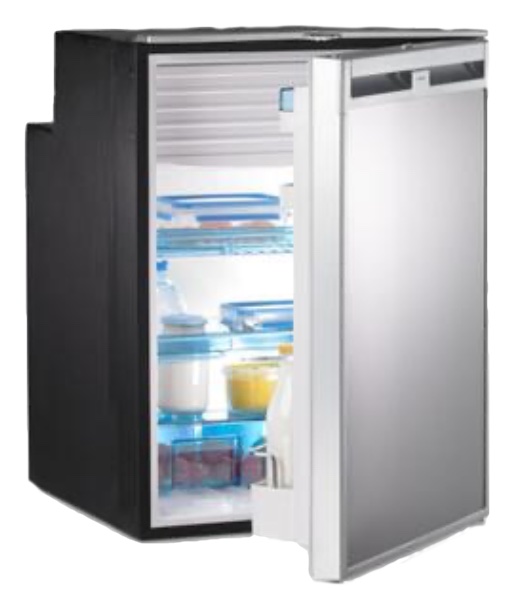 The No. 1 appliance that drives the need for a reliable 12V power supply, and is the biggest user of 12V electricity in the average campsite, is a refrigerator.
The No. 1 appliance that drives the need for a reliable 12V power supply, and is the biggest user of 12V electricity in the average campsite, is a refrigerator.
Remember, electricity supply is measured in Amps. The average upright camping fridge will draw between 2 amps and 4 amps, consuming anything from 2 Ah per hour to 4 Ah per hour from your battery. This is affected by a number of variable factors – the size of the fridge, if it includes a freezer compartment, the ambient air temperature, how often the fridge is opened and closed, etc, etc.
For the purposes of this article, let’s estimate on the ‘high side’, and say our camping fridge is consuming 3 Ah of electricity per hour in our summer campsite, and is running 24 hours a day.
-
- 3 Ah per hour x 24 hours = 72 Ah of 12V electricity each day. Just for the fridge.
I am going to take a shortcut here, and suggest that when you add in other appliances and gadgets that use 12V electricity you will soak up a total of around 90 Ah of stored electrical energy per day (24 hrs).
Of course if you are camping in a tent and only using a small (50L) single-zone chest fridge, running LED lights at night and charging phones, you will use much less than that – maybe as little as 30-40 Ah.
If you are camping in a motorhome and running a larger fridge, a TV, a water pump for your kitchen and bathroom, an inverter for your hair dryer, sandwich press, toaster, coffee maker, and microwave oven, then you might be draining 110 Ah or more electricity from your batteries each day.
Horses for courses!
How big a battery will you need to store enough electricity to run your appliances? If your appliances are using 90 Ah of electrical energy a day (24 hrs), and your battery has a ‘usable’ capacity of under 100 Ah, it isn’t too hard to work out that the electrical energy stored in your battery won’t last more than a day running your appliances. But don’t despair – all is not lost – read on!
-
- More info: Appliance Power Consumption >>>
Batteries
 Batteries suitable for powering campsites are available in a range of storage capacities. They all look like the batteries we see when we look under the bonnet of a car with an internal combustion engine (ICE) – but their construction and chemistry is very different.
Batteries suitable for powering campsites are available in a range of storage capacities. They all look like the batteries we see when we look under the bonnet of a car with an internal combustion engine (ICE) – but their construction and chemistry is very different.
The batteries fitted under car bonnets are known as starter batteries, and are designed to supply a large burst of energy for a very short time – enough energy to turn the starter motor to start your car.
The batteries used for powering your 12V appliances at the campsite are known as deep-cycle batteries and are designed to supply a steady stream of electricity over a longer period of time.
A popular capacity for camping batteries (often referred to as ‘leisure’ batteries or ‘house’ batteries) is 120 Amp Hours (Ah). Theoretically a 120 Ah battery can supply 3 amps for 40 hours. Only theoretically though. Read more below about ‘usable capacity’.
Note: If you only have a basic van setup, or are camping in a tent, then a Portable Power Station with a built-in battery might be all you need. More info at the bottom of this page.
Just to make it more confusing!
Lead-acid batteries (the most common type you will see are called AGM batteries) are widely used in caravans, Campervans and Motorhomes, and have given great service to the camping industry for many years. They are very heavy – 30kg (because of the Lead content) – but also relatively cheap (about $250 for a 120Ah battery). Lithium batteries are much lighter (around 12kg), last a lot longer, but are much more expensive ($400 – $900 for a 120Ah battery). To keep it simple, in this article we are going to talk mostly about Lithium batteries. If you are buying a battery, and your budget can afford it, go for a Lithium battery from a reputable retailer. (Yes, there are Lithium cheapies online, and there are many pros and cons. Mostly cons.) If the budget is tight, then AGM batteries will still keep the fridge cold, albeit for a little less time than their Lithium cousins. |
Usable capacity
 So, you have a 120 Ah Lithium battery, and your electrical appliances (fridge, lights, phones, iPads) are chewing through 90 Ah of electricity every day.
So, you have a 120 Ah Lithium battery, and your electrical appliances (fridge, lights, phones, iPads) are chewing through 90 Ah of electricity every day.
Here is another gotcha – Lithium batteries should only be depended upon to supply 80% of their labelled capacity. If you completely flatten the battery – ie, use all 120 Ah of its storage capacity – the life-span of the battery will be compromised and it may drop into ‘safe mode’, where it is not visible to the battery charger. (Read how to recover from Safe Mode.)
A 120 Ah Lithium battery should be considered as having a usable storage capacity of 96 Ah. (Lead-acid batteries operate on a 50% usable capacity – a 120Ah AGM battery should only be counted on for 60Ah of stored energy.) Some manufacturers claim their Lithium batteries can supply a full 100% of their storage capacity. Maybe. But we will play it safe, and base our calculations around the 80% figure, even if only to preserve the battery life-span.
With this 96 Ah of usable electrical storage, and our appliances draining 90 Ah every day, our 120 Ah Lithium battery will only be able to power our campsite for about 1 day, without being recharged.
Extending our storage capacity
Being able to run all our 12V appliances for only one day is not ideal! What if we are away for a whole weekend? Or a week? Or longer?
This is where it all gets interesting, and even more complicated – read on to discover how we can extend our 12V electrical storage capacity beyond just one day…..
More batteries
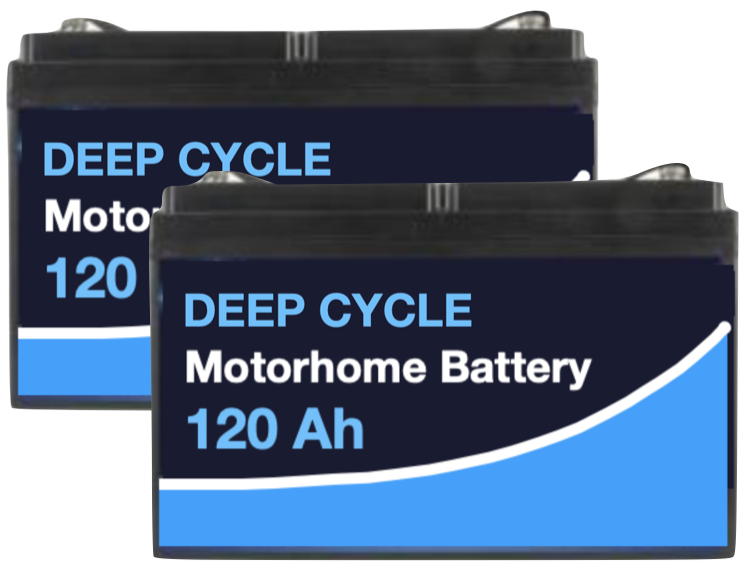 If you only have a small fridge, and you are tent camping with only modest electrical usage, one 120Ah battery will most likely be enough. Ditto for a small camper trailer.
If you only have a small fridge, and you are tent camping with only modest electrical usage, one 120Ah battery will most likely be enough. Ditto for a small camper trailer.
However, many campervans and motorhomes have two (or more) 12V batteries connected ‘in parallel’ – a wiring arrangement that combines their storage capacity while maintaining their output voltage of 12V.
Two 120 Ah Lithium batteries (connected in parallel) can store 240 Ah of electricity, or a usable 192 Ah of capacity.
That instantly doubles your storage capacity, and off-grid camping longevity.
But wait – that’s only the start – there’s much more….
-
- More info: Our Lithium Battery Upgrade >>>
Recharging batteries
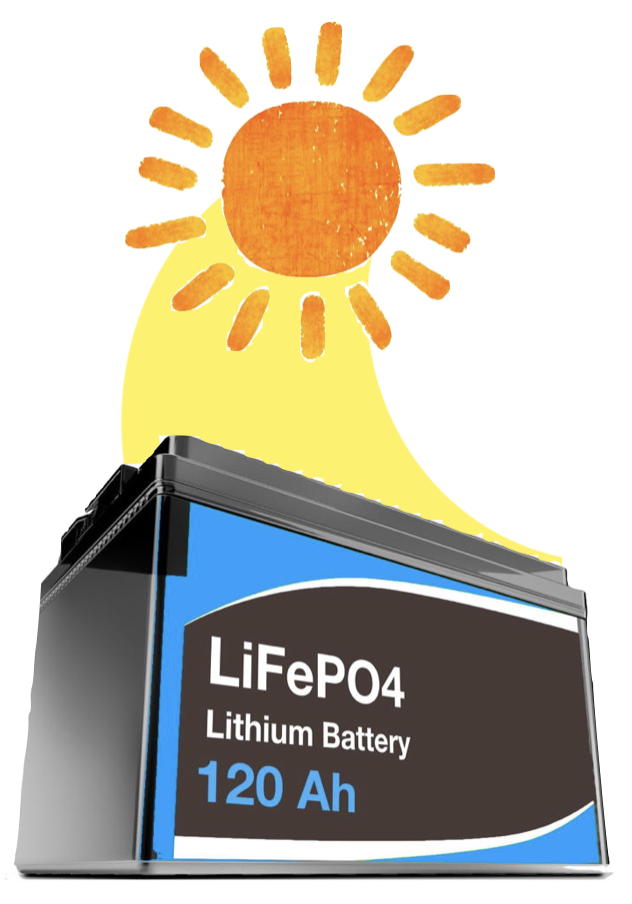 Batteries are storage vessels for your electrical energy.
Batteries are storage vessels for your electrical energy.
Deep-cycle batteries used for camping can be ‘refilled’, or recharged. Batteries can have their electrical energy restored so they can continue to supply electricity to your 12V appliances.
How does this happen? Batteries become discharged when all the electrons on one set of plates (-ve) have moved to the other set of plates (+ve) as part of the process of providing electricity to appliances. Electrical energy can be used to push those electrons back to where they came from – recharging the battery. (Read more: Battery charging basics.)
Where does this recharging energy come from? It can come from….
-
- Solar panels – converting the energy available from the sun into electrical energy;
- The vehicle alternator – which is already generating electrical energy to charge the engine starter battery;
- A 230V power supply – if you have one available.
All three of these sources of electrical energy need to connect to your batteries through a battery charger / regulator – devices that tailor the electrical output from the generating source to suit the electrical input requirements of your battery/s.
Important: You can’t simply connect an electricity supply (solar panel / car alternator / 230V outlet) directly to your 12V batteries – this will destroy your batteries! You MUST use a battery charger….
Hey Charger!
There are different types of battery chargers – regulators that are designed for connecting only solar panels to batteries, chargers to feed electrical current from the car alternator, and chargers for converting 230V mains current to electrical current suitable for charging your 12V batteries.

If you are tent camping, and all you need is enough electricity to keep the fridge cold, then all you probably need to keep your battery charged is a suitable size solar panel and a solar charger, sometimes referred to as a solar controller. These are generally purchased as a package. (Most portable camping fridges have built-in electrical circuitry for running the fridge from a 12V socket when the car is running.)

There are two types of solar controllers – PWM and MPPT. Without going into all the details, PWM controllers are older technology and are the cheaper of the two options. MPPT controllers are a little more expensive, but are far more efficient, especially in low light conditions, and are the preferred option to buy.
If you want to keep your battery/s charged while you are driving then you will need a charger to connect between the vehicle alternator and the battery/s. While you are driving, the vehicle alternator is busy spinning around generating electricity to charge your vehicle’s starter battery, so you might as well syphon off some of that spare current and send it to your camping batteries. These chargers are known as DC-DC chargers (Direct Current to Direct Current) and are standard fittings in Campervans and Motorhomes.

Most DC-DC chargers fitted to campervans and motorhomes are ‘dual input’ – you can connect your alternator and your solar panels to the same battery charger, which tailors its output to suit the needs of your battery/s.

An AC-DC charger (Alternating Current to Direct Current) is used to charge your batteries from a mains power supply.

-
- More info: Recharging Campervan Batteries >>>
Recharging batteries from solar panels
Solar panels are widely used for ‘off-grid’ battery recharging. Panels are typically labelled with their claimed power output in Watts (W).
If you are looking to purchase a solar panel, look for a 150W or 200W panel. And a solar controller / charger, if you don’t already have a battery charger. (The packed size of the panel is another factor to consider when checking out portable panels or blankets.)

Solar panels in this range are advertised as supplying from 6 amps to 10 amps per hour to the battery, depending on the size of the panel and how much sun is shining. (Solar panels generate maximum output when the surface of the panel is perpendicular to the angle of the sun.)
In theory a 200W solar blanket (which runs at around 20V) could supply up to 10 amps of electricity to your batteries, based on the formula Watts = Volts x Amps, or Amps = 200W / 20V.
Experience suggests that the real output from a 200 Watt solar blanket is around 6 – 7 amps, maximum, in the middle of the day. Maybe around 4 – 5 amps at 10:00 am. This output is dependent on a number of factors, including the quality of the materials used to manufacture the panels. (Fixed glass panels are likely to have a better output than a foldable blanket – will update when tested.)
If your fridge is drawing up to 3 amps from the battery to keep itself cold, then the solar panel needs to be supplying at least 3 amps per just to balance the fridge usage, before any additional current is returned to the battery.
But, as night time rolls around, and there is no sun to generate electricity to charge the battery, your batteries have to have enough storage capacity to supply 3 amps (that’s 3Ah discharge per hour) all night to keep the fridge cold until the morning. That might be 10 hours at 3 Ah per hour, or 30 Ah all up.
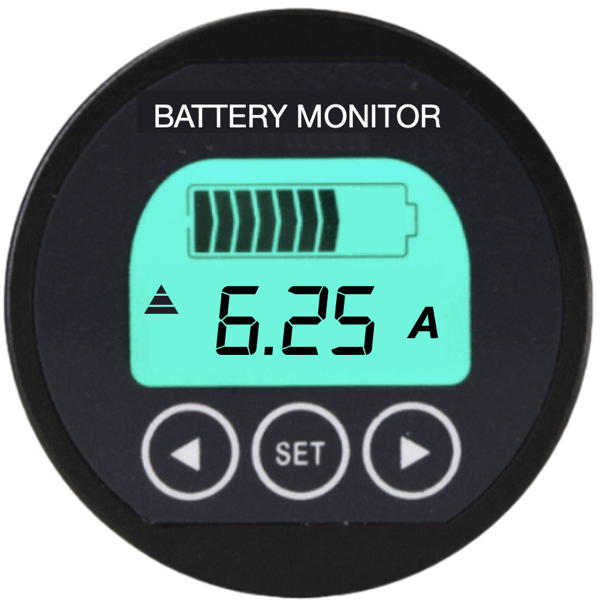 Once the sun comes up, your solar panel comes to life and starts feeding electricity into the batteries via the solar controller. Not only does your solar panel need to return 3 Ah per hour to compensate the batteries for the immediate current being drawn by the fridge, but also needs to be generating enough extra electrical energy to concurrently top up the 30 Ah deficit from the previous night.
Once the sun comes up, your solar panel comes to life and starts feeding electricity into the batteries via the solar controller. Not only does your solar panel need to return 3 Ah per hour to compensate the batteries for the immediate current being drawn by the fridge, but also needs to be generating enough extra electrical energy to concurrently top up the 30 Ah deficit from the previous night.
If your solar panel is returning 6 Ah per hour, and your fridge is using 3 of those Ah each hour to keep itself cold, then you have only 3 extra Ah to top up last night’s battery drain. Let’s say you only get the full 6 amps current from your solar panel over 6 hours while the sun is high in the sky in summer, that’s only 3 ‘extra’ amps over and above what your fridge is using each hour, so only 18 Ah is returning to your battery storage over the 6 hours to replace the 30 Ah consumed during the night. That’s a deficit of 12 Ah.
If your 120 Ah Lithium battery has a usable storage capacity of 96 Ah, and you are running a net deficit of 12 Ah per day, the maths (96 divided by 12) says that you can do this for 8 days before your battery is discharged below a safe level. And that is 8 good sunny days, and using electricity only for your fridge.
If you are only away for the weekend, or only camped in the one place for a few days, that’s not a problem. For a longer-term off grid expedition you can add an extra panel, which will restore up to an extra 6 – 7 Ah per hour (when the sun is shining).
Other Charging Options
 Of course, solar panels are only one source of electrical energy that can be used to recharge your batteries. Once you go beyond the basic charging options and setup a more permanent arrangement, you can have multiple charging sources, some sharing the same charger, but all feeding into the battery.
Of course, solar panels are only one source of electrical energy that can be used to recharge your batteries. Once you go beyond the basic charging options and setup a more permanent arrangement, you can have multiple charging sources, some sharing the same charger, but all feeding into the battery.
Car Alternator: If you have a DC-DC charger connected to your alternator, you will be charging your batteries at around 20 – 40 Ah per hour, depending on the specs of your DC-DC battery charger, whenever you start the engine.
230V Mains Supply: If you are in a Campervan or Motorhome with a built-in AC-DC battery charger and you plug the van into mains power at a caravan park, your system should be setup so that your batteries automatically begin recharging. This will be at a rate of around 10 – 30 Ah per hour, depending on the specs of your battery charger.
If your fridge is a 12V / 230V compressor fridge (the most common Campervan option) it will switch automatically to 230V power when mains power is available.
Many caravan parks now have mains power available for tent campers too, so you can plug your portable fridge directly into the mains supply and not worry about recharging batteries!
Power Inverters
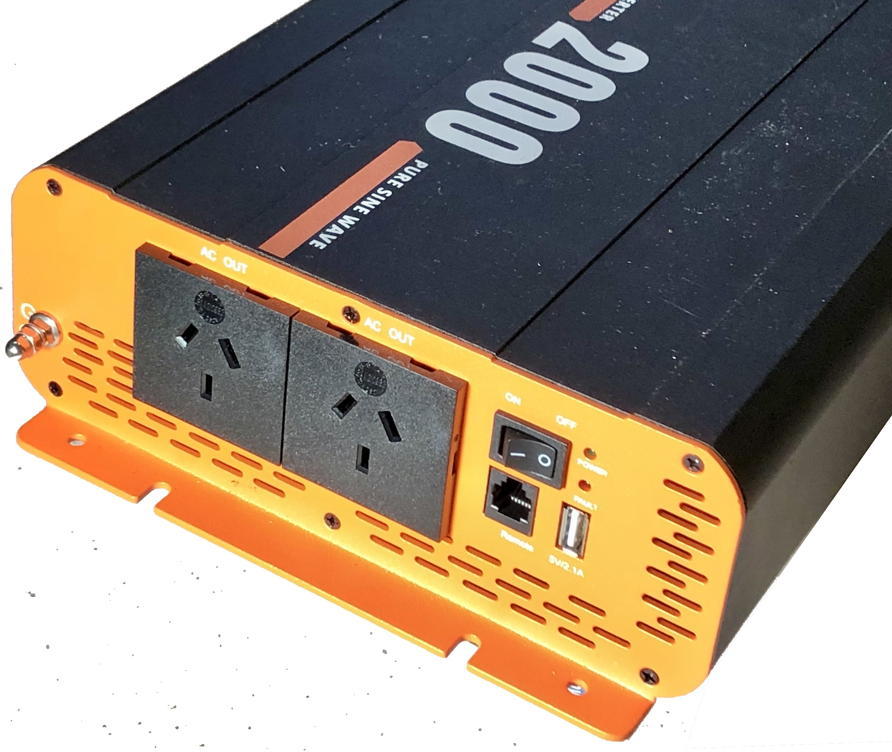 OK – This is not a real necessity, but rather one of those optional extras that has become possible / popular as a result of advancing technologies.
OK – This is not a real necessity, but rather one of those optional extras that has become possible / popular as a result of advancing technologies.
A power inverter is a gadget that converts (inverts) 12V DC electricity from your batteries to 230V AC electricity, just like you have available from power outlets at home. That means you can plug in the microwave oven, the induction cooktop, the coffee machine, the hair dryer or the sandwich press and run them from your 12V campervan batteries.
Well – maybe!
These appliances draw massive amounts of current from your 12V batteries. Remember that your 12V camping fridge is using 3 Ah per hour from your precious 96 Ah stored battery capacity. A microwave oven running through an inverter is drawing 140 amps, depleting your battery storage at then rate of 140Ah per hour!
Fortunately the microwave oven is running for only a short time – a few minutes, rather than a full hour. However in 5 minutes your microwave oven will have drained 12 Ah from your battery (140÷60×5=11.6). That’s 4 hours of fridge time. Without going into all the details here, you will need at least 2 lithium batteries and a very solid cabling infrastructure for the successful use of a power inverter to regularly run power-hungry electrical devices.
And a good charging setup to generate enough electrical energy to replace the current drained from the batteries.
-
- More info: Installing an Inverter in our Campervan >>>
Connecting it all together
 All the gadgets mentioned above – batteries, chargers, solar panels, fridges, inverters, etc – are connected together with copper wires.
All the gadgets mentioned above – batteries, chargers, solar panels, fridges, inverters, etc – are connected together with copper wires.
Like water pipes feeding water to your shower, copper wires have to be thick enough to carry the electrical current from the batteries to the appliances to which they are connected. If the wires are too thin, not enough electrical current will get through to the appliances and they won’t work properly.
In a worst case scenario the wires may even overheat, melt the plastic insulation, and cause a fire.
It is critical when connecting your 12V electrical gear that you use the correct gauge cable – especially for high current devices like batteries and inverters. And your fridge, if you want it to stay cold.
-
- More info: 12V Wire and Cabling >>>
The Big Picture
So, once you have your batteries, appliances, and charging devices all setup, they need to be joined together …. here is a typical layout for a Campervan or Motorhome…

Fortunately it is not as complicated as it looks!
Some extra power supply stuff for tent and car campers….
Battery Boxes
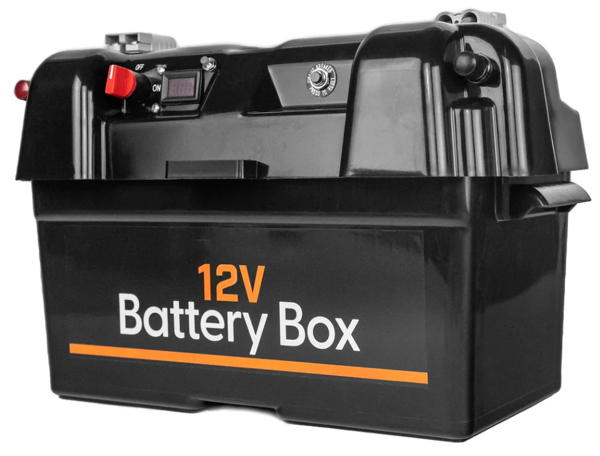 All you need to run your fridge is a battery. But how do you store your battery, and connect your fridge and other devices to the battery?
All you need to run your fridge is a battery. But how do you store your battery, and connect your fridge and other devices to the battery?
A powered Battery Box turns your battery into a mini power station. It holds your battery securely, and is pre-wired with easy connection points – Anderson plugs, 12V Cig sockets, USB outlets and clamp-on terminals. Most of these boxes also provide a voltmeter and circuit breaker.
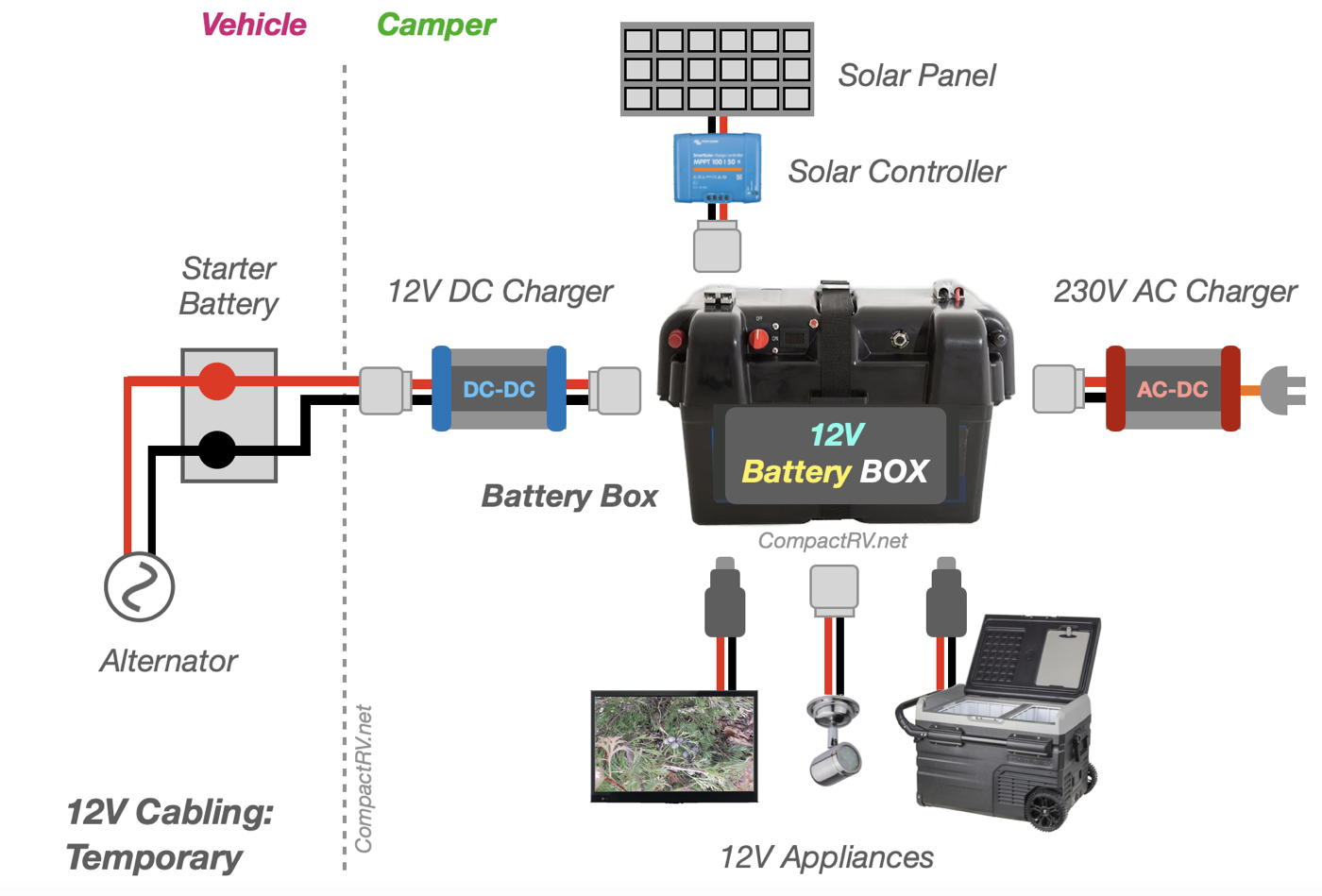
A Battery Box is the cheapest and easiest way to add an AGM battery to your portable camping setup, and can be easily hooked up to a solar panel and chargers.
- You can also fit a Lithium battery in a Battery Box, though once you add up the cost of a Lithium battery and start adding AC and DC chargers, an inverter, etc, a Portable Power Station starts to become a more cost effective option.
-
- Battery Boxes: iTechWorld Battery Box | Adventure Kings Battery Box
- On the Go: A portable fridge & 12V power supply
Power Stations
 A Portable Power Station is like a Battery Box on steroids.
A Portable Power Station is like a Battery Box on steroids.
A more recently-available gadget, made possible by Lithium batteries and clever associated technologies, the Portable Power Station is ideal for those camping in tents without a full Campervan environment available. Or maybe in a Kombi van with just a bed and a fridge fitted inside.
Portable Power Stations are built around a Lithium battery, with built-in chargers for solar, alternator and 230V, an array of 12V outlets for fridges, mobile phones, etc, along with 230V outlets connected to a built-in inverter. All in a single compact box with a carry handle.
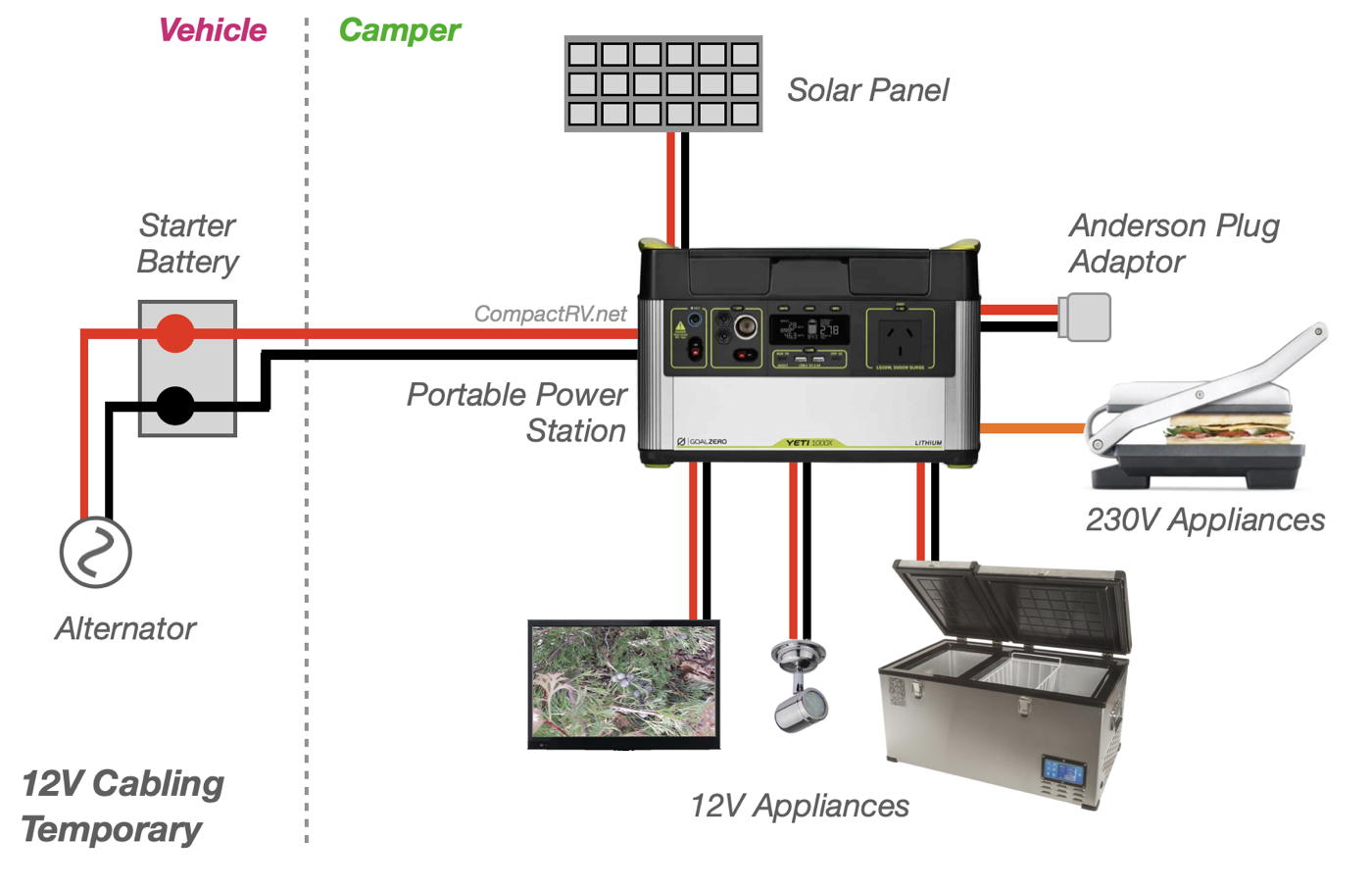
Cost varies depending on the capacity of the internal Lithium battery and inverter. A Power Station with a 100Ah battery will set you back around $2000, while a power station with a 50Ah battery is around $1000. You wouldn’t want less than this if your fridge is consuming 30Ah overnight.
|
Out in the real world….
In summer, the fridge uses less than 1 Ah per hour of stored battery capacity. So if we setup camp on a Friday night with a fully charged battery (running from the car while travelling) the fridge is still running when we pack up on Sunday afternoon. The 40Ah power station battery lasts all weekend, so long as we don’t get too carried away using the inverter. (After 48 hours the power station display indicates 22% capacity remaining.) Plus we also have the 15Ah built-in battery in the fridge. That’s at least another 10 hours of fridge run time. And for added insurance our solar panel plugs directly into the power station – to keep electrons flowing into both batteries – so a weekend away with a small power station powering a fridge (and topping up mobile phones) is not a problem. Fully recharging the Compact 600 on the AC adaptor when we return home takes around 6 hours. See also: Kickass 600 video (now superseded) >>> |
-
- Power Station examples: iTechWorld | Goal Zero | KickAss
Fridges
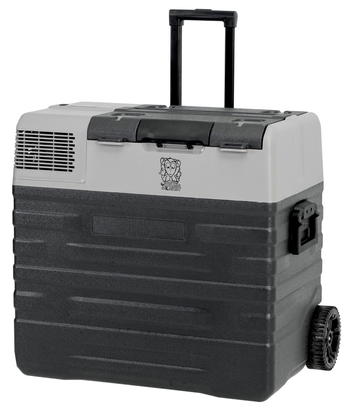 A wide range of portable fridges / freezers is available from the usual camping equipment suppliers.
A wide range of portable fridges / freezers is available from the usual camping equipment suppliers.
A very ‘easy’ option for those needing a portable fridge for short camping trips is the Brass Monkey range, available from Jaycar and Road Tech Marine.
What makes these fridges different to others? Many of the fridges in this range have a built-in battery compartment, holding an optional removable battery, along with a built-in solar charger, AC-DC charger and DC-DC charger, and includes Bluetooth app control.
The fridge connects to a 12V cig socket and runs from your car battery while driving, then switches to the built-in battery when camped off-grid. Or the fridge can be plugged into a 230V outlet if camped on a powered site.
The built-in battery is easily charged by plugging a solar panel into the socket on the side of the fridge. (No external solar controller required.) The battery can also be recharged from 230V mains power or from the car alternator while driving. The charging electronics for both AC and DC charging is built-in to the fridge.
The largest available clip-in battery is only 15.6 Ah, which will power the fridge for about 12 hours. For any further time off the grid (without sunshine) a spare built-in battery might be handy ($229), or (for around the same price) an external battery / power pack, such as the Kings 24Ah Power Pack.
I have seen the built-in battery in one of these fridges keep the fridge cold for over 10 hours, which suggests the fridge is using around 1.0 – 1.5 Ah of stored battery energy per hour. (ECO mode on, and voltage protection set to Medium.)
A neat all-round option. The fridge could also be plugged into a Battery Box or a portable Power Station to extend off-grid operability.
-
- See also: 12V Wire & Cabling
- Case Studies: 12V power cut-outs | Battery not charging
Batteries | Consumption | Battery Recharging | Solar Charging | How Long Without Sun? | Alternate Charging Options | Solar Regulators | The Bottom Line
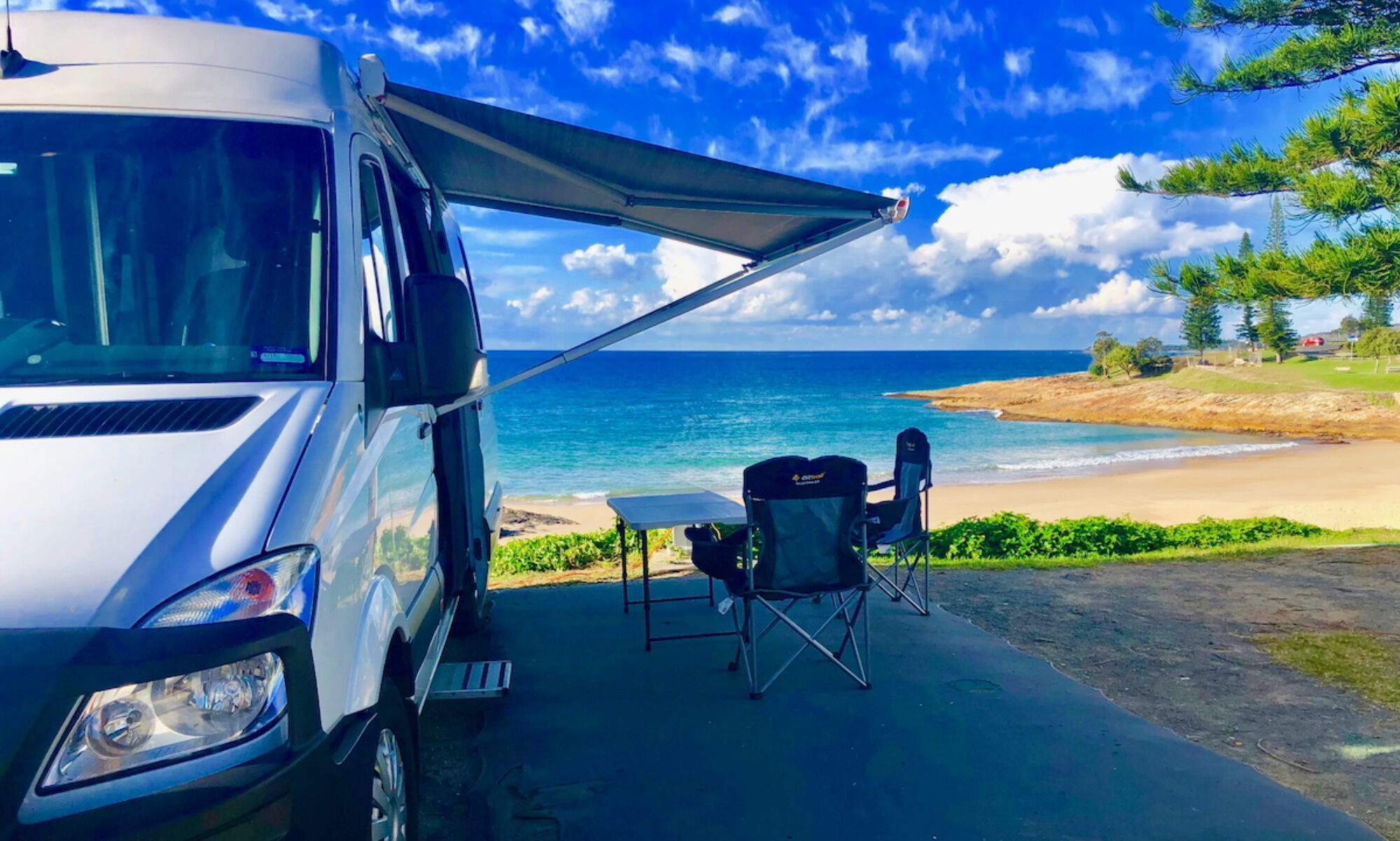
 12V Campervan appliances are powered by electrical energy;
12V Campervan appliances are powered by electrical energy; Solar panels are marketed based on their power output, measured in Watts. A 200W solar blanket can theoretically return ‘up to’ 10 Ah per hour to the battery storage. Experience suggests that the reality may only be a maximum of 6 – 7 Ah per hour (in good conditions), depending on the quality of your solar panel;
Solar panels are marketed based on their power output, measured in Watts. A 200W solar blanket can theoretically return ‘up to’ 10 Ah per hour to the battery storage. Experience suggests that the reality may only be a maximum of 6 – 7 Ah per hour (in good conditions), depending on the quality of your solar panel; A powered Battery Box is a popular budget-friendly option, providing a secure housing for your 12V battery, while making it easy to connect appliances, chargers, or a solar panel to the battery. (You will also need a charger/s to connect a solar panel or DC-DC or AC-DC chargers.)
A powered Battery Box is a popular budget-friendly option, providing a secure housing for your 12V battery, while making it easy to connect appliances, chargers, or a solar panel to the battery. (You will also need a charger/s to connect a solar panel or DC-DC or AC-DC chargers.)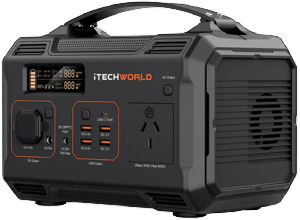 A Portable Power Station is an alternative to a Powered Battery Box, providing a convenient ‘all-in-one’ option for the provision of a 12V power supply (including a 230V inverter) when camping without the built-in 12V infrastructure of a Campervan or Motorhome. (Most portable power stations include built-in chargers for recharging the power station battery from solar, 12V DC, and 230V AC.)
A Portable Power Station is an alternative to a Powered Battery Box, providing a convenient ‘all-in-one’ option for the provision of a 12V power supply (including a 230V inverter) when camping without the built-in 12V infrastructure of a Campervan or Motorhome. (Most portable power stations include built-in chargers for recharging the power station battery from solar, 12V DC, and 230V AC.) Brass Monkey fridges – some models include an optional removable battery (that can keep the fridge cold for up to 10 hours), along with a built-in solar charger, 230V AC charger and 12V DC car charger. Ideal for day trips or when used in conjunction with a Powered Battery Box or Portable Power Station for longer excursions.
Brass Monkey fridges – some models include an optional removable battery (that can keep the fridge cold for up to 10 hours), along with a built-in solar charger, 230V AC charger and 12V DC car charger. Ideal for day trips or when used in conjunction with a Powered Battery Box or Portable Power Station for longer excursions.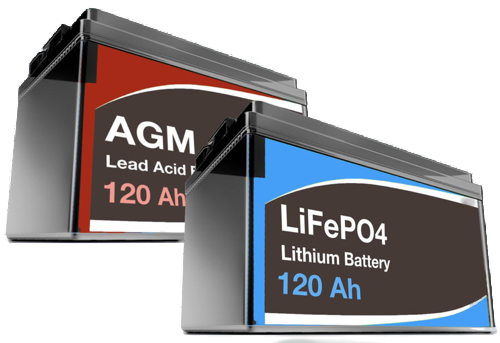
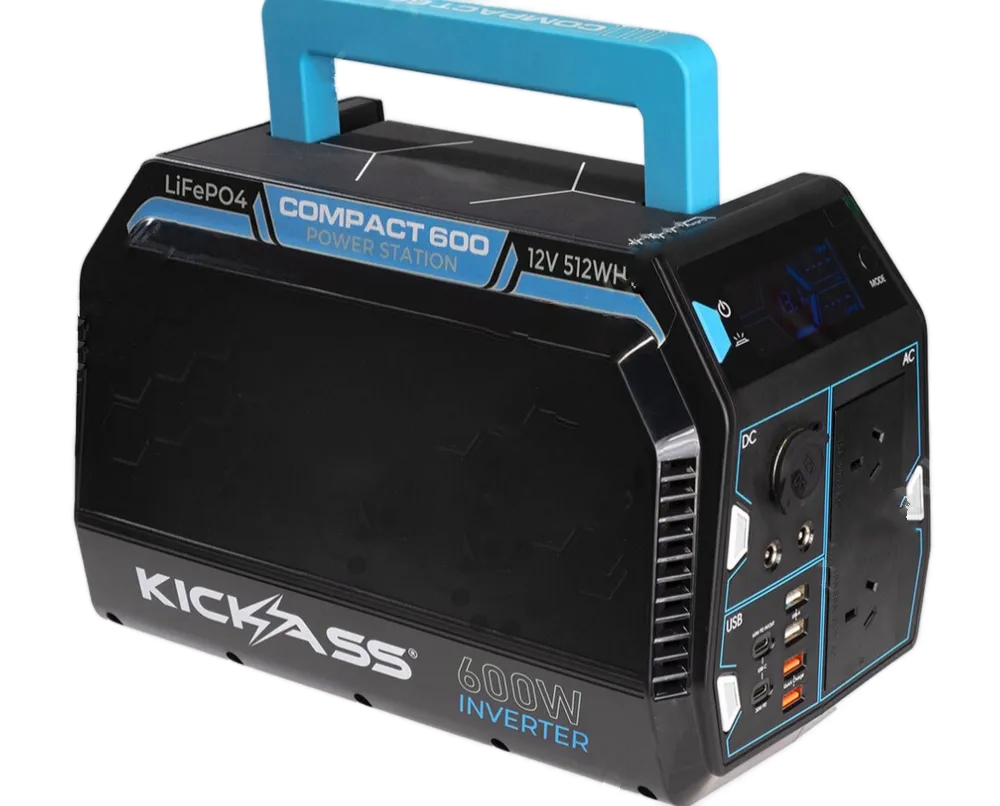 We have been away camping for the weekend with our Rovin (Brass Monkey) 42L portable fridge (with a built-in battery) connected to a Kickass Compact 600 power station – which includes a 40Ah (512 Wh) battery and 600W inverter.
We have been away camping for the weekend with our Rovin (Brass Monkey) 42L portable fridge (with a built-in battery) connected to a Kickass Compact 600 power station – which includes a 40Ah (512 Wh) battery and 600W inverter.